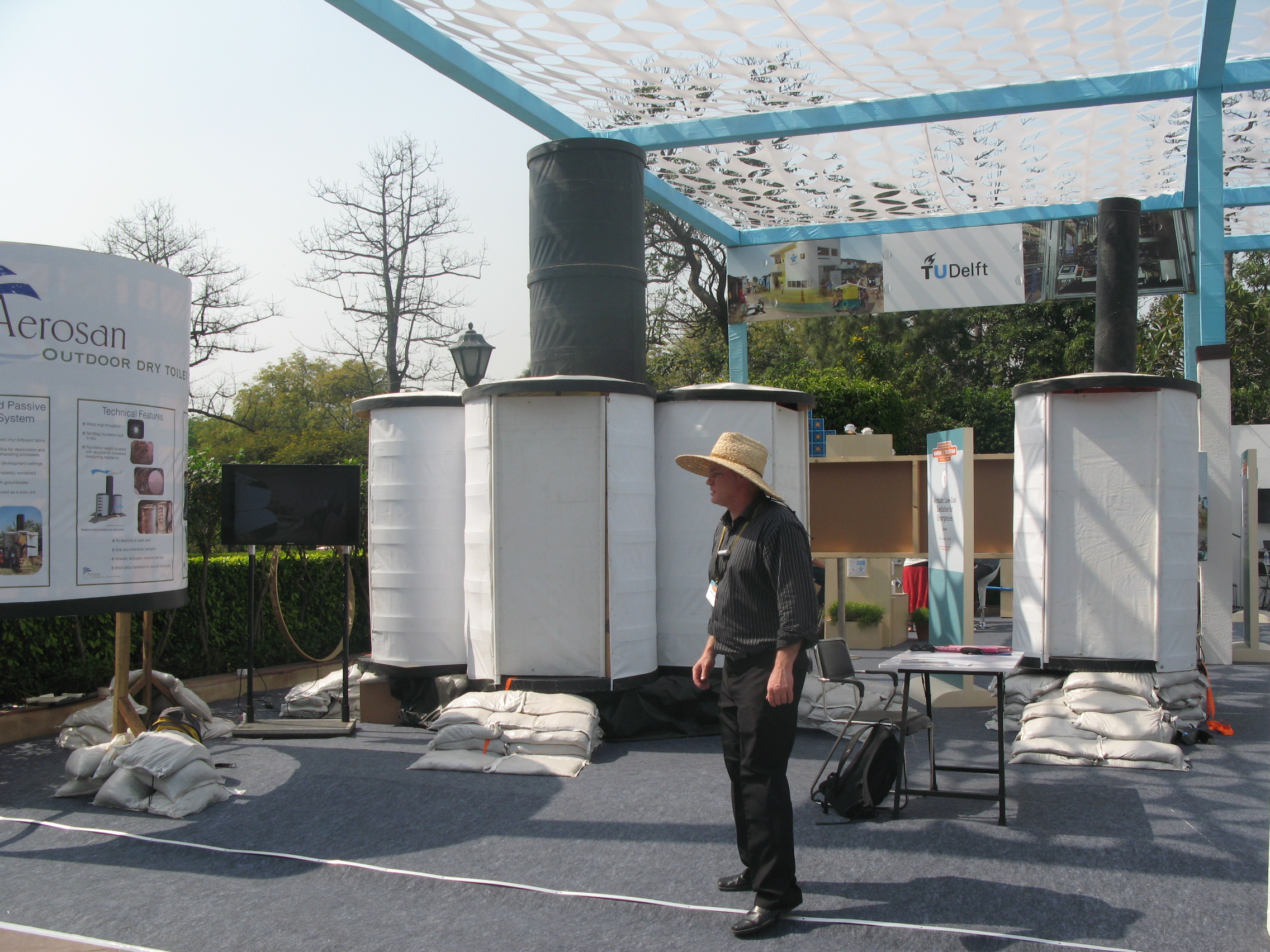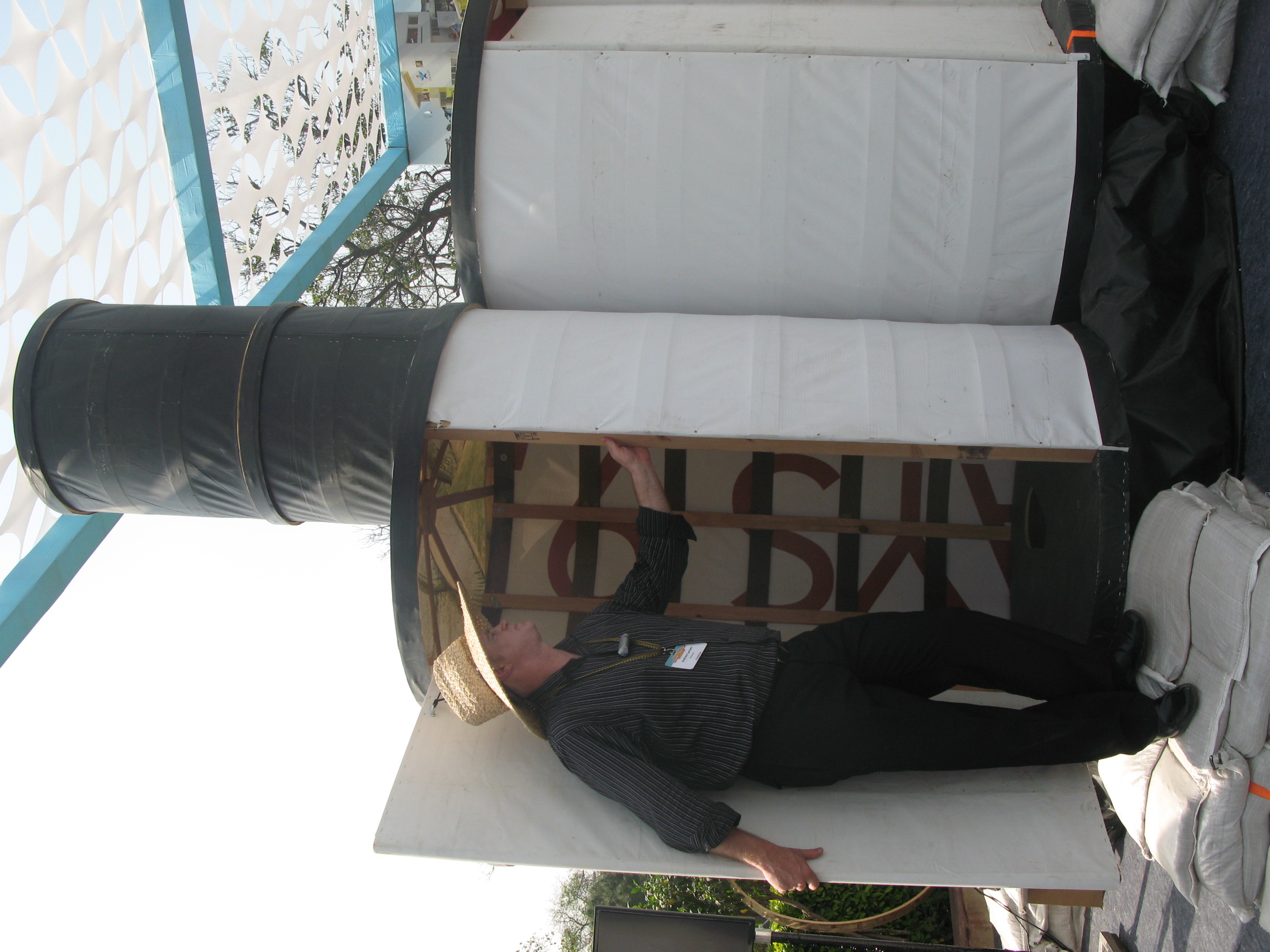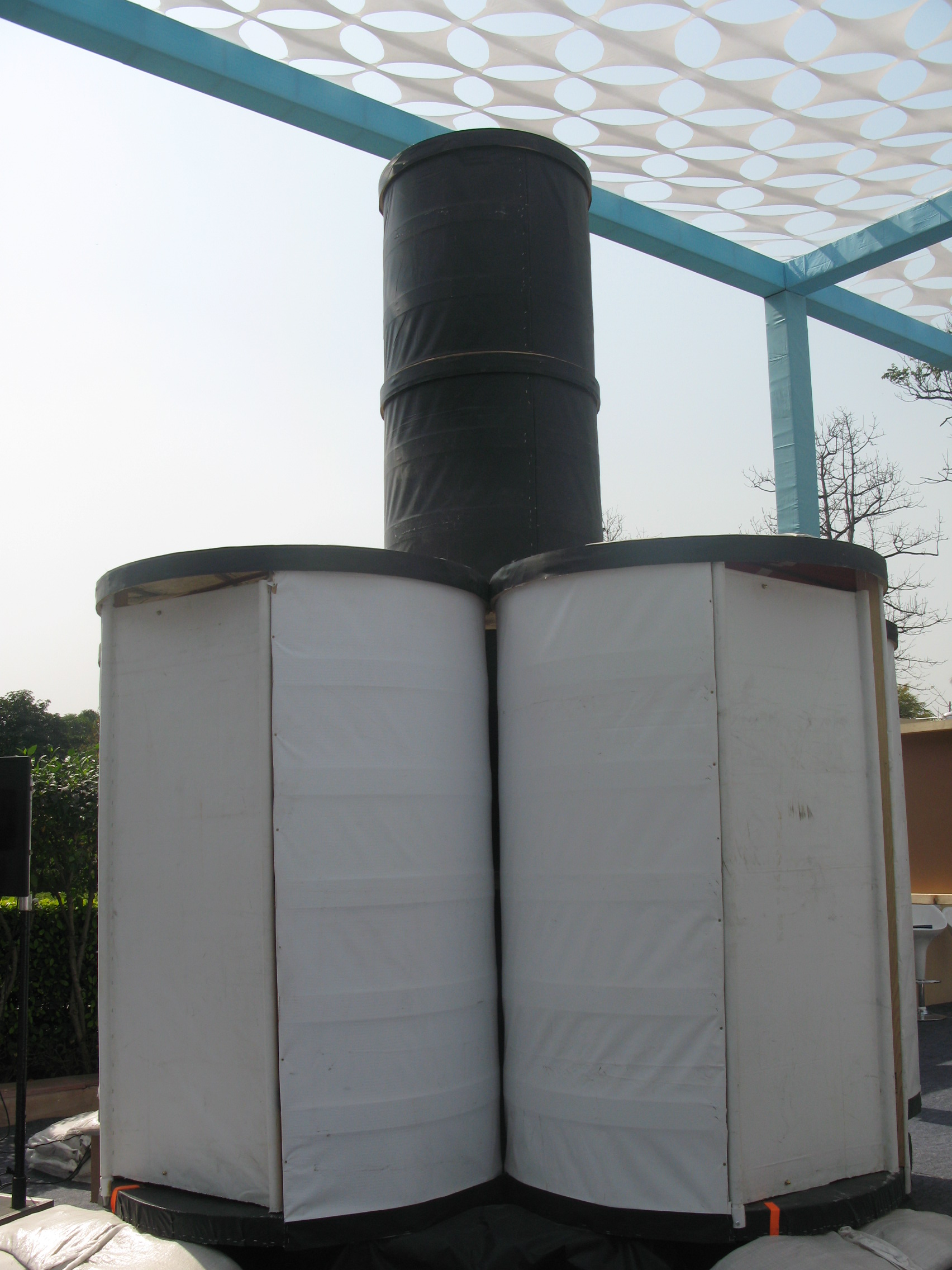- Forum
- categories
- Sanitation systems
- Toilets without urine diversion
- Innovations and research in toilet design
- Low-Cost Sanitation for Emergencies, tested in Haiti (Aerosan, USA and Haiti)
Low-Cost Sanitation for Emergencies, tested in Haiti (Aerosan, USA and Haiti)
38.9k views
Thanks for your comments! The bags are made of the same material as the cubicles--the used vinyl billboard fabric. In the ones in Haiti they were somewhat large (1.5 m3) with the idea that the first part of the composting would occur at the toilet site. In practice, we found that it was better to compost everything at a secondary site and so we moved the partially full bags of the five arrays in operation (5 toilets per array) and set that up. It's not ideal and moving the material was difficult. Having the toilet superstructures be moved back and forth onto two bins (like a giant fossa alterna) was the idea, but it was harder to do in practice than we had originally thought. So the Haiti toilets are still functioning and not filling very fast (due to a level of composting which is decreasing volume even if it's not performing the hygienization process that we want), so they are working but the emptying of those systems remains a challenge. We are working on a different design which will be for single toilet units and which will be much easier to handle as far as maintenance is concerned.
I like the cylindrical approach as well--there are a lot of structural benefits to building them that way. We have only built these ones you see in the videos for the Delhi show. We are looking at going to single units and will be emphasizing the pack-ability/ship-ability issue, but I don't have a video of that. My new idea has us going away from the cylinders (at least for the moment) for a few reasons. Not sure how that will work out at the moment, but I feel like we have some good ideas.
The flexible strips for the walls were a problem in the India units--we had used masonite, which I didn't like, but it worked for the time being. I want to use strips cut from the 2 x 4s and am experimenting with that a bit.
We do not have a tech guide as of yet in Kreyol.
The rate of filling was one of the pleasant surprises to us--we found that they just weren't filling up and when we went to look at them 9 months after initial set-up, they were not full then, but we changed out the bags anyway, as described above. The thing is, I think there is a fair amount of volume loss due to the decomposition like you say, and I would like to be able to quantify that at some point.
As far as temperature monitoring, we did that while we were living in Cite Soleil with our own compost pile and found that we could regularly get temperatures over 70 C. We turned our compost often and experienced the spike at least 5 times before it gradually decreased. We were composting in Vodrey (our village) on the edge of Cite Soleil.
And yes, SOIL we know very well--Sasha and her team have made a ton of progress as far as promoting composting as a treatment method for sanitation. GiveLove, with whom I've also worked, has done a lot in that area as well.
Sorry for the late reply--I am not checking these posts often enough! Please feel free to ask anything else. There are some things about our design that I'm not satisfied with, and I think that's why I'm still trying some new ideas. The one thing I can say that I think we have a better handle on is the building style using wood and billboard fabric with each iteration. Each time we build something from these materials we learn more about how to perfect the building style itself--which is separate from all the process stuff, but a necessary part of a low-cost humanitarian solution.
Regards,
Andrew
Please Log in to join the conversation.
You need to login to reply- MonikaR
-
 Less
Less- Posts: 7
- Karma: 2
- Likes received: 3
Just saw your videos on the AeroSan composting toilet model - congrats! It was great to read your comments to Chris and Ben's questions, and I have a few more for you if you don't mind:
-I didn't see the collection bags in your videos, but am wondering what the bag removal process is like as well as the cleaning process for them
-I like the round model of the toilets - really nice to look at. Have you done any scouting in Haiti as to the availability of the flexible woods strips? I would also love to see a demo video for how the 4-unit system packs down for transport, and how easy it would be to set up in an emergency situation. Have you tried to develop a tech guide yet in Haitian Kreyol for local teams to be able to use?
-Wonderful that you're finding the toilets need less maintenance with the material reduction as a result of the aerobic decomposition. How often are you having to empty the contents then, and with kind of usage in Cite Soleil?
-Have you identified a site to compost, and how are you monitoring the temperatures?
Congratulations again on the AeroSan initiative. I would also suggest (if you haven't done so already) to check out SOIL's EcoSan activities in Haiti (both Port-au-Prince and Cap Haitian). SOIL has been operating since 2006, has similar emergency toilet models, and perhaps could offer beneficial information exchange and collaboration.
Best of luck!
Monika
Please Log in to join the conversation.
You need to login to replyAndrew
Please Log in to join the conversation.
You need to login to reply- ben
-

- Water and sanitation engineer
Less- Posts: 107
- Karma: 11
- Likes received: 57
Thanks for your reply, I'll try to catch you on skype !
If I had one comment, the sensibilisation about sanitation emergency really depend on the kind of festival ... your design is probably more adapted to big events which usually involve a lot of alcohol, drugs and crazyness, than little eco-festival where people would be probably more receptive.
Best of development in your great project, we'll keep a sharp eye on it so thanks for sharing news.
Ben
Please Log in to join the conversation.
You need to login to replyThanks for your comments and interest!
@Ben: The festival idea is one we've been thinking about for a while--we're just not scaled up for it yet, but it is something we like. One thing, it provides the festival-goers (who are often interested in developing-world issues anyway) a chance to see how this works--both for them (while at the festival) and for others of the world, who find themselves in a humanitarian emergency. So I think that is a good angle. I will look at the links you have there on festival toilets in Europe. One of my very good friends, Rodrigo Silva, has worked at Boom in Portugal for several years. He and I were tent-mates in Port-au-Prince right after the earthquake in 2010. Do you know him by chance? I will copy my colleague, Hana Nelson, and let's see about the Florent connection. My skype is andrew.larsen66--feel free to add me and we can talk more. I am 8 hours behind you (France).
@Chris: The choice for UD or all-in-together can be done as a final design stage, though at this point it is all-in-toegether. That's how we're currently set up in Haiti. That was easier to implement. I have a lot of ideas about UD since there are many benefits as you know. The excreta are collected in a bag which is made out of the same, very durable, reused billboard fabric.
The chimney is simply black billboard fabric. As it turns out, all the billboard fabric is either white or black on one side with the printed advertisement on the other. We get both types since the white is better for the cubicles (less solar gain), and the black is ideal for the ventilation plenum (chimney). All of it is flex PVC with a nylon scrim embedded into it, and, all of it has UV-resistance built into it. The level of "embodied engineering" as I call it, is quite high--thus the main reason I like it so much as a reuse thing.
In a rain event, the structure sheds water very well (we've lived through two hurricanes in Haiti since we put those up), and the bag keeps all excreta out of the water--be it rainwater or groundwater--that is a key design feature. We do not want any untreated excreta having any communication with random water of any kind.
The optimal diameter of the chimney is a guess at this point--more is better--is the strategy, but I want to research that particular question. At first glance, it is related to the surface area of the plenum--the larger it is the slower the air can move (driven by the Venturi flowing above) in order to move a lot of air--but there are limits to that. We will also be measuring air velocities through the system as the relate to ambient conditions--that is, I want to have sensors in the plenum and at the toilet openings and map out what happens at a variety of outside conditions. This is a research area we are getting into hopefully soon (we will be collaborating with some other engineers on this problem).
We have measured the velocities and they are variable. At times there will be a very strong draw (into the toilet opening) indicating good airflow, but at other times things slow down or stop. I think the multiple unit array may experience manifolding problems which may make it so air is going into one toilet and possibly exiting another--again, this is something I want to test. In any case, the odor control has been excellent, according to our families in Haiti who are using the current ones. Moving more air than is necessary for ventilation crosses into the realm of having as much as possible for aerobic composting (even if it is not complete at the toilet stage).
We don't know for sure on life of the vinyl fabric but it seems to be lasting quite well (units installed in July 2012). It's pretty stout stuff so I think it's up to the task for quite a while. There is no comparison with the standard blue tarps which degrade really quickly in the incessant UV of tropical sun.
Ya, I like the cement idea--where the fabric becomes the form for the application. We've thought about that too, but haven't gone down that road yet. Like you say, it could be an interesting way to make an emergency unit more permanent--which is nearly always needed in most emergencies.
Thanks to both of you for your questions and comments--let's keep the discussion going. I apologize for not being on the forum--I just need to have it be a regular thing that I'm watching going forward.
Thanks Elizabeth for the original post and pictures!
Regards,
Andrew
Please Log in to join the conversation.
You need to login to replyThis is a very interesting system. I have some questions:
## What is going on inside? (How are feces collected? Is urine kept separate? If so, where does it go? etc.)
## Is the black cloth for the chimney simply billboard cloth painted black? (What paint?)
## What happens when it rains? (Does it just soak into the ground, without getting the feces wet?)
## What is the optimal diameter of the chimney (and how can this be determined)?
## Have you measured the velocity of the air?
## Does air ever go the wrong way?
## How long would the vinyl billboard material last in a permanent use in the sun?
## How are things going in the field?
For a more permanent application, a thin layer of cement (potentially mixed with clay, polypropylene fibers from old sacks, resin, etc.) could be blown or splattered onto the outside.
Thanks, Ben, for bringing this back to the surface.
Best wishes,
Chris Canaday
Omaere Ethnobotanical Park
Puyo, Pastaza, Ecuador, South America
inodoroseco.blogspot.com
Please Log in to join the conversation.
You need to login to reply- ben
-

- Water and sanitation engineer
Less- Posts: 107
- Karma: 11
- Likes received: 57
I wanted first to congartulate you on this amazing product you made, every little detail is very smart, simple and functional. And on top of that, you actually made it very attractive ! Bravo
Some idea was crossing my mind as I'm starting a dry toilet renting company in the south of France : What would you think to replicate and adapt your system for festivals here in France, and a part of the benefits would go back to some of your programs.
I'd like to develop different models of peer to peer development, just like Chris ELAIN who wrote a book on dry toilets systems and proposed then to finance a program with the benefits.
You can see here discussions on the festival toilet market in Europe. I have no doubt your design adapted to "mix this with humour, art, music and education/awareness raising." as says Enno, would be real a hit here !
I work with flax fiber and composite materials here, many design fantaisies are therefore possible.
As was mentionning Florent, the annual meeting of french dry toilet renters is happening next weekend and I could talk about this with then. Everyone there is pretty activist so we could develop together and share an adapted "open source" design that any renter could use in France at the condition some money is given to your program. The contract would be moral though, no law in france would support this arangement, what would you think ?
You can contact me at this adress This email address is being protected from spambots. You need JavaScript enabled to view it.
Looking forward to hear from you,
Ben
Please Log in to join the conversation.
You need to login to reply- Elisabeth
-
- User is blocked
- Freelance consultant since 2012
Less- Posts: 3372
- Karma: 54
- Likes received: 932
Re: Low-cost sanitation for emergencies - Aerosan in New Delhi
Thanks for your post, good to see you back on the forum! These two videos are well worth watching, I think you have some very nifty, low-cost design ideas there for light-weight mobile toilets for emergency settings (trialled in Haiti). I really admire your enthousiasm which comes out clearly in the videos - and boy, was it a hot day! We were sweltering in that heat in March in Delhi (no shade!).
For those without access to Youtube, I provide here some photos from the exhibit.
Here is the link to the album on flickr:
www.flickr.com/photos/gtzecosan/sets/72157644270369664
And here are some example photos from that album:




Freelance consultant on environmental and climate projects
Please Log in to join the conversation.
You need to login to replyCheers,
Andrew, Hana, Dave, Attilus
My interview about project story (questions asked by Elisabeth):
In this video you can see me giving a guided tour of our exhibit (it was a hot day with little shade!!):
Short description copied from Technical Guides (susana.org/lang-en/library?view=ccbktypeitem&type=2&id=2001), page 5:
Aerosan: Low-Cost Sanitation
for Emergencies
Aerosan has developed a four-toilet array as well as a
separate single-unit cubicle. Key to the design is the
use of enhanced passive ventilation for both control of
odors and also drying of excreta. The material can be
subsequently composted. The low-cost construction
approach using re-purposed vinyl billboard fabric allows
for a large plenum (a space provided for air circulation
and venting), which, driven by a Venturi is able to move
more air through the system than would normally be
available in a typical 4” (100 mm) vent pipe. The design
puts the outlet of the plenum 15’ (4.3 m) above the
ground, so odors are released at a higher elevation than
typical vented toilet cubicles.
Several units have been deployed for field testing in Haiti
and are operating at a high level.
The unit shown at the Delhi toilet fair is fully functional
and will be an improved design from the one shown
at the first toilet fair in Seattle in 2012. Design
improvements have focused on reducing the weight, cost,
and improving the wall and plenum structures. Also,
the whole design will be available in kit form for use in
emergencies.
How it works
The primary technical feature of this toilet is the design
of a passive ventilation system which draws more air
than is necessary for simple odor control. In this way,
a degree of drying takes place which reduces volume
accumulation of excreta and thus increases the number
of users that can use the system per maintenance
period. Ventilation is both wind and solar-driven, but all
passive.
Please Log in to join the conversation.
You need to login to reply- gitum
-

- Environmental Engineer pursuing PhD at Technical University of Munich
Less- Posts: 14
- Karma: 2
- Likes received: 4
Re: Urban sanitation solutions for high-use, flooded, and difficult to serve areas in Haiti
It’s a very interesting project. I also pursue my PhD on WASH issues in Onaville in Canaan area, Haiti which increase my interest on your project. If you don’t mind, I also would like to ask you couple of questions regarding to your work.
How often do you collect excreta from the collection bin below the toilet for transferring it to a composting site (every 6 months or so)? How far and how big is the composting site? How do you manage the composting facility?
I am also curious on your community involvement work. Currently, we work in collaboration with a local NGO, TECHO. TECHO informed us that there is lack of local sanitation expert in the area to start the community education on WASH. How did you solve this issue? Did you work with SOIL or another Organization? Also, how long did the community awareness education take?
Moreover, in my previous research I come up with the problem of helminths in Haiti. I saw from your presentation at FSM-2 Conference that 60°C, 1 week hemophilic composting process will be enough for pathogen removal. Still, I am curious if you have any information on helminths.
Best,
Gökce
Research Assistant
Technical University of Munich
e-mail: This email address is being protected from spambots. You need JavaScript enabled to view it.
www.tum-ias.de
www.sww.bv.tum.de
Please Log in to join the conversation.
You need to login to reply- Ekane
-
 Topic Author
Topic Author- Nelson Ekane (PhD)
Less- Posts: 32
- Karma: 2
- Likes received: 10
Re: Urban sanitation solutions for high-use, flooded, and difficult to serve areas in Haiti
Just breaking the silence and redirecting our discussion back to Haiti.
It is good that community leaders in Haiti were involved in the awareness campaigns you had and that the families using the toilets have taken the responsibility of maintaining the toilets. This is an indication of ownership which is key for sustainability of these toilet blocks. I am, therefore, interested in knowing the arrangement(s) these families have put in place for cleaning the toilet blocks i.e. what contributions are made for cleaning in cash and/or kind? who does what in cleaning and how often do they clean? Also inform about the arrangement and remuneration of the team of 4 people responsible for other operation and maintenance (O&M) activities beyond cleaning.
It is good that local materials are used and that the blocks are inexpensive to construct. What is the cost of the construction materials for a toilet block i.e. local lumber, nails, etc. Are the billboards obtained for free? How much was the labour cost for construction (in cash and kind)?
Finally, what were the direct support costs of the awareness campaigns and how long were these campaigns?
Best regards,
Nelson
Research Fellow
Stockholm Environment Institute (SEI)
This email address is being protected from spambots. You need JavaScript enabled to view it.
www.sei.org
Mobile: +46 (0) 768722110
Please Log in to join the conversation.
You need to login to replyRe: Urban sanitation solutions for high-use, flooded, and difficult to serve areas in Haiti
Andrew
Please Log in to join the conversation.
You need to login to reply- Forum
- categories
- Sanitation systems
- Toilets without urine diversion
- Innovations and research in toilet design
- Low-Cost Sanitation for Emergencies, tested in Haiti (Aerosan, USA and Haiti)








